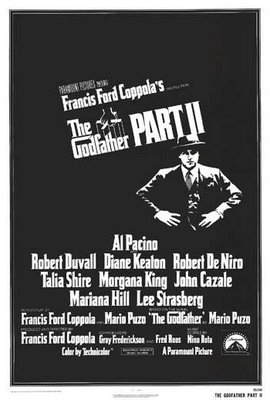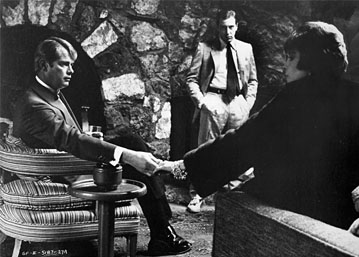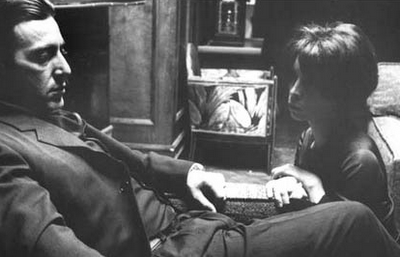 Francis Ford Coppola's The Godfather Part II enjoys such extraordinary and enduring acclaim that the contrarian in StinkyLulu just pines to rant against this 187 minutes of passion, pasta and period costumes. (Indeed, the mere presence of Lee Strasberg in the cast -- & on the nomination roster -- is nearly enough to get Lu in a rabid attack lather.) But goldarnit, the movie is pretty freakin' good. The Godfather Part II accomplishes the kind of emotional and historical sweep that really should cause the film to just collapse under the weight of its own pretensions; that it doesn't is one of the architectural marvels of modern cinema. Even more, the movie showcases Al Pacino at the height of his gift (and hotness) and provides the vessel for a jawdroppingly effective performance by Robert DeNiro (who's just astonishingly sexy, speaking Italian in sepia tone, dreamier even than a young Brando...woof). But, for this actressexual, there's the lady question. To wit: where are they? And on this front, the film does disappoint mightily, offering as paltry sustenance the thin but sturdy reed of a performance by...
Francis Ford Coppola's The Godfather Part II enjoys such extraordinary and enduring acclaim that the contrarian in StinkyLulu just pines to rant against this 187 minutes of passion, pasta and period costumes. (Indeed, the mere presence of Lee Strasberg in the cast -- & on the nomination roster -- is nearly enough to get Lu in a rabid attack lather.) But goldarnit, the movie is pretty freakin' good. The Godfather Part II accomplishes the kind of emotional and historical sweep that really should cause the film to just collapse under the weight of its own pretensions; that it doesn't is one of the architectural marvels of modern cinema. Even more, the movie showcases Al Pacino at the height of his gift (and hotness) and provides the vessel for a jawdroppingly effective performance by Robert DeNiro (who's just astonishingly sexy, speaking Italian in sepia tone, dreamier even than a young Brando...woof). But, for this actressexual, there's the lady question. To wit: where are they? And on this front, the film does disappoint mightily, offering as paltry sustenance the thin but sturdy reed of a performance by...

...Talia Shire in The Godfather, Part II (1974).
approximately 11 minutes and 56 seconds on-screen
9 scenes
roughly 6% of film's total screen time
In The Godfather Part II, Diane Keaton (as Pacino's/Michael's love Kay) and Talia Shire (as Corleone sister, Connie) both reprise the roles they created memorably in the original Godfather. In Part II, however, the film divests Keaton of narrative significance, relegating her to the mostly symbolic arc of the "white woman among the wops" who's just not sure how to extricate herself. Shire's Connie has a starker character transformation -- marked in several clusters of short scenes -- but, even then, Shire's Connie is there mostly to perform symbolic narrative gestures.
 Early on, there's the first batch of short scenes, where Shire's Connie (as the trashy divorcee arriving late to the family party) tries to wheedle money -- but maybe some approval too -- from her exacting brother and disappointed mother. Connie's defiance is adolescent and, in these early scenes,
Early on, there's the first batch of short scenes, where Shire's Connie (as the trashy divorcee arriving late to the family party) tries to wheedle money -- but maybe some approval too -- from her exacting brother and disappointed mother. Connie's defiance is adolescent and, in these early scenes, Shire's performance conveys the desperate smugness of a woman who waited until her 30s to rebel. Then, all at once, Shire's Connie is gone and remains so -- without even a referential mention -- for nearly ninety minutes, until Mama Corleone dies. In this second cluster of scene-lets, Shire's Connie (as the "only sister" chastened by her absence from her now-dead mother's life) endeavors to make amends, first with her brother and then with the family
Shire's performance conveys the desperate smugness of a woman who waited until her 30s to rebel. Then, all at once, Shire's Connie is gone and remains so -- without even a referential mention -- for nearly ninety minutes, until Mama Corleone dies. In this second cluster of scene-lets, Shire's Connie (as the "only sister" chastened by her absence from her now-dead mother's life) endeavors to make amends, first with her brother and then with the family (by orchestrating a "reunion" of the estranged Michael and Fredo). Then, again, Shire's Connie's drops away from the narrative for nearly an hour, until -- for her final bundle of scenes -- she's back, this time as the Corleone's surrogate matriarch, announcing arrivals and insisting upon departures, before a concluding flashback remembers her as the idealized, innocent little sister.
(by orchestrating a "reunion" of the estranged Michael and Fredo). Then, again, Shire's Connie's drops away from the narrative for nearly an hour, until -- for her final bundle of scenes -- she's back, this time as the Corleone's surrogate matriarch, announcing arrivals and insisting upon departures, before a concluding flashback remembers her as the idealized, innocent little sister.These three beats -- rebellion to contrition to tradition -- could provide a powerful character arc for Connie,
 but the film doesn't just doesn't go there. And, unfortunately, neither does Shire. The movie seems to forget all about Connie until she shows up out of nowhere, and Shire's performance provides little in the way of nuance to suggest where Connie might have been in the meantime. Only in the scene with Keaton's Kay does Shire provide a hint of Connie's complexity; otherwise, it's all shrill defiance or strategic submission...as if that's all a woman can do. Shire's is not a bad performance, not by any means (which StinkyLulu had to begrudgingly concede upon rescreening this film), but Shire's Connie isn't much of a performance either.
but the film doesn't just doesn't go there. And, unfortunately, neither does Shire. The movie seems to forget all about Connie until she shows up out of nowhere, and Shire's performance provides little in the way of nuance to suggest where Connie might have been in the meantime. Only in the scene with Keaton's Kay does Shire provide a hint of Connie's complexity; otherwise, it's all shrill defiance or strategic submission...as if that's all a woman can do. Shire's is not a bad performance, not by any means (which StinkyLulu had to begrudgingly concede upon rescreening this film), but Shire's Connie isn't much of a performance either.• • • • •
See you at this Sunday's
Supporting Actress
Smackdown for 1974!
Supporting Actress
Smackdown for 1974!


No comments:
Post a Comment